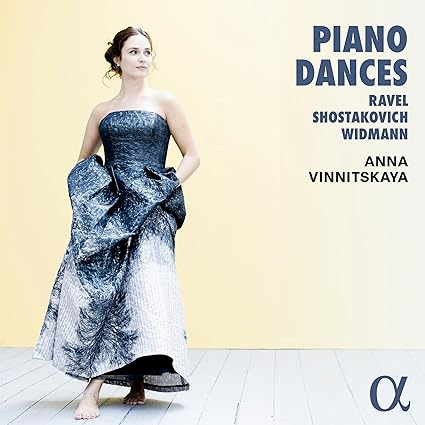

Maurice Ravel (1875-1937): Valses nobles et sentimentales, M.61 Dmitri Shostakovich (1906-1975): Puppentänze Jörg Widmann (b. 1973): Zirkustänze, (2012) Maurice Ravel (1875-1937): La Valse, M.72
Since winning the 2007 Queen Elizabeth Piano Competition in Brussels, Anna Vinnitskaya has gone on to create an impressive series of releases and also a career including a Professorship at the Hochschule für Musik und Theater, Hamburg where she had trained under Evgeni Koroliov.
In the 2007 competition she gave a stunning performance of Ravel's Gaspard de la Nuit, and she has since released an album of that as well as other Ravel pieces and separately one of the composer's piano concertos. She plays more Ravel in this release; the composer is clearly a favorite of hers. In addition, she plays some of her countryman Shostakovich and some intriguing music by contemporary composer Jörg Widman. Thus, the overall program has an interesting variety, topped and tailed by Ravel, the finale being a thrilling performance of La Valse, acting as a wonderful encore to send virtual audiences out satisfied and energized.
There can be no doubt of the technical capability of Ms. Vinnitskaya's playing. We seem today to be graced with an impressive number of up and coming technically gifted soloists in the younger generations, and while already an experienced pianist I count her in that august group. So, the real question is does a soloist present as much musicality to match that technical excellence. With few hesitations, I believe this performance does match that standard. Her approach is one that massages the music with gentle rubato to emphasize the incredible beauty of key moments, and also the wit and poignancy that is inherent in much of what is presented here.
The 'Valses nobles et sentimentales' presents several examples. The first movement is a notably clear and bold opening statement, and it contrasts with a gentler and dreamy 2nd movement 'Assez lent, avec une expression intense', beautifully played with the intensity increasing as the movement proceeds. The graceful playing culminates in a sensitive and pensive final movement, the longest of the piece, to recede into the distance with the echoes of waltzes left hanging in the air.
The Shostakovich Puppentänze (Dances of the Dolls), was arranged mainly from some of the composer's film and stage works. It was expressly written for younger players, and thus is intentionally less technically challenging. It is played in an engaging manner that engenders many smiles of pleasure in this listener. This is evident starting with the lovely lopsided sounding first waltz, exhibiting the oblique humor characteristic of the composer but without the biting sarcasm so often displayed in some of his greatest and more well-known works. This continues in the second movement Gavotte and beyond. The final movement ends in a sudden flurry of notes, as if the pianist is having a final joke with us, and it is tossed off with great aplomb. The overall work does not plumb many philosophical depths, but is quite frankly a very pleasurable work, easy to listen to and sounds simply enjoyable to play.
The Widmann 'Zirkustänze' (Circus Dances) that follows is in a more modernistic idiom, more complex to listen to at first, but it too has considerable wit and finesse. It starts with a semi-strident fanfare movement, quite a contrast with the preceding Shostakovich dances, but then proceeds into a witty boogie-woogie movement. There follows the first of the waltz movements proper, and though the waltz rhythms peek through it is not one I would attempt to dance to! Ms. Vinnitskaya proves to be an able and keen advocate for this piece, painting the varied moods articulately as the work moves through what seems like almost dreamlike variations looking back into earlier periods of life. For example, one of the pieces reflects on homelessness, another on a nursery rhyme, each piece fixing on a brief remembrance of a place or a musical style. The 8th movement, picturing a waltz tune in a carousel at a circus is a good example of the recognizable waltz ethos, but distorted in recollection by off-kilter harmonies and sudden rushes of notes. It is really a tantalizing traversal of the waltz form and rewards several listens.
The recital is completed by the longest individual piece overall, the extraordinary 'La Valse'. From the low grumbling opening, dancers as seen through a mist to the bright lights of the dance floor with dancers flowing across the imaginary screen in front of the listener, the whole progression is brought to light by some excellent playing, lovingly managing the pulse of the music throughout. As we near its end, it boils over into an almost uncontrolled ecstasy, and we almost feel the dancers almost hallucinatory total exhaustion. It is a fitting end to the recital. Ravel was fascinated through his life with the fundamentals of dance rhythms in general and the waltz rhythm in particular. One thinks of the beautifully gentle slow movement of the Piano Concerto in G in addition to the works on this release.
I found the recording quality overall extremely clear, enabling an impressive dynamic range. This is rewarding release and deserves to be heard.
Ian Orbell - April 2024 Ending of 'La Valse'